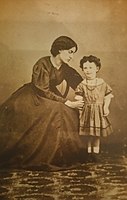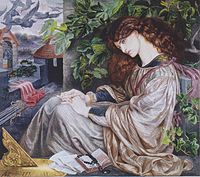Jane Morris
Jane Morris | |
|---|---|
Pre-Raphaelites | |
| Spouse | |
| Children | Jenny Morris May Morris |
| Relatives | Elizabeth Burden (sister) |
Jane Morris (née Burden; 19 October 1839 – 26 January 1914) was an English
Life
Jane Burden was born in
In October 1857, Burden and her sister
She became a skilled needlewoman, self-taught in ancient embroidery techniques, and later became renowned for her own embroideries.[2]
Jane married William Morris at
In 1871, William Morris and Rossetti took out a joint tenancy on Kelmscott Manor on the Gloucestershire–Oxfordshire–Wiltshire borders. William Morris went to Iceland, leaving his wife and Rossetti to furnish the house and spend the summer there.[5] Jane Morris had become closely attached to Rossetti and became a favourite muse of his. Their romantic relationship is reputed to have started in the late 1860s and lasted, on differing levels, until his death in 1882. They shared a deep emotional connection, and she inspired Rossetti to write poetry and create some of his best paintings. Her discovery of his dependence on chloral hydrate, which was taken for insomnia, eventually led her to distance herself from him, although they stayed in touch until he died in 1882.[7]
In 1883, Jane Morris met the poet and political activist Wilfrid Scawen Blunt at a house party given by her close friend, Rosalind Howard (later Countess of Carlisle).[5] There appears to have been an immediate attraction between them. By 1887 at the latest, they had become lovers.[8] Their sexual relationship continued until 1894 and they remained close friends until her death.[citation needed]
A few months before her death, she bought Kelmscott Manor to secure it for her daughters' future. However, she did not return to the house after having purchased it. Jane Morris died on 26 January 1914, while staying at 5 Brock Street in Bath. She is buried in the churchyard of St. George's Church in Kelmscott.[5]
Gallery
-
Jane sketched by William Morris at age 18, during their engagement
-
Jane and Jenny Morris c. 1864
-
Jane and May Morris, c. 1865
-
Dante Gabriel Rossetti:Pia de' Tolomei, c. 1868
-
William Morris reading to Jane Morris while she takes the waters at Bad Ems, by Dante Gabriel Rossetti (1869)
-
Morris painted byProserpine(1874)
-
Dante Gabriel Rossetti –The Day Dream, 1880
Paintings and artworks

Jane Morris's embroidery:
- Bag, embroidered silk. c.1878, Colored silks, metal mount. Victoria & Albert Museum, London.
- The Legend of Good Women embroidered panels, 1880s, by Jane Morris and Elizabeth Burden, Castle Howard.[2]
- Honeysuckle embroidery, designed in 1876, made 1880s, silk and linen, William Morris Gallery, London.[9]
Paintings of Jane Morris by Dante Gabriel Rossetti:
- The Blue Silk Dress, 1868.
- Proserpine or Proserpina, 1874. Oil on canvas. Tate Britaingallery, London.
- Astarte Syriaca, 1875–1879. City Art Gallery, Manchester.
- Beatrice, a Portrait of Jane Morris, 1879. Oil on canvas 13+1⁄2 × 11 inches.
- The Day Dream, 1880. Oil on canvas. Victoria and Albert Museum, London.
- La Donna della Fiamma, 1877. Coloured chalks. Manchester Art Gallery.
- La Donna della Finestra, 1879. Oil on canvas. Fogg Museum of Art, Harvard University, Cambridge, USA.
- La Donna Della Finestra, 1881 (unfinished).
- Jane Morris, c. 1860. Pencil.
- Jane Morris, 1865.
- Mariana, 1870. Aberdeen Art Gallery.
- Pandora, 1869.
- Pandora, 1871.
- La Pia de' Tolomei, 1866–1870. Oil on canvas. Spencer Museum of Art, University of Kansas.
- Portrait of Mrs William Morris.
- Portrait of Jane Morris, 1858. Pen.
- Reverie, 1868. Chalk on paper. Ashmolean Museum, Oxford, UK.
- The Roseleaf, 1865. Pencil.
- Study of Guinevere for Sir Lancelot in the Queen's Chamber, 1857.
- Water Willow, 1871. Delaware Art Museum
Photographs of Jane Burden by Rossetti are available at [1].
By William Morris:
- Numerous stained-glass windows, including at Christ Church, Oxford.
By Evelyn De Morgan:
- The Love Potion 1903[10]
- Chalk study of Jane Morris for The Hourglass, 1904. De Morgan Foundation
- The Hourglass 1905 De Morgan Foundation Wightwick Manor
References
- ^ "Janey Morris: Pre-Raphaelite Muse". National Portrait Gallery. Retrieved 9 March 2020.
- ^ ISBN 0-517-56799-7.
- Oxfordshire Limited Edition, no. 249, pages 23–25, October 2007; and picture of blue plaque
- ^ Marsh, Jan (2000). Jane & May Morris: A Biographical Story. Horsham, UK: Printed Word. pp. 5–6.
- ^ JSTOR 10.3366/j.ctt3fgtfq.7.
- ISBN 978-1-884446-05-4. Retrieved 9 March 2020.
- ISBN 978-1-884446-05-4. Retrieved 9 March 2020.
- ^ Mancoff, p.98
- ^ Willem. "Morris, Jane, 1839-1914". trc-leiden.nl. Retrieved 9 March 2020.
- ^ "A drapery study for 'The Love Potion'". Christie's. 2017.
Further reading
- Marsh, Jan (1986). Jane and May Morris: A Biographical Story 1839–1938. London: Pandora Press. ISBN 0-86358-026-2.
- Marsh, Jan (2000). Jane and May Morris: A Biographical Story 1839–1938 ((updated edition, privately published by author) ed.). London: Jan Marsh.
- Mancoff, Debra N. (2000). Jane Morris: The Pre-Raphaelite Model of Beauty. San Francisco: Pomegranate. ISBN 0-7649-1337-9.
- Sharp, Frank C and Marsh, Jan, (2012) The Collected Letters of Jane Morris, Boydell & Brewer, London
- Sharp, Frank C., ‘Morris [Burden], Jane (1839–1914)’, Oxford Dictionary of National Biography, Oxford University Press, 2004
- Parkins, Wendy (2013). Jane Morris: The Burden of History. Edinburgh: Edinburgh University Press. Retrieved 9 March 2020, from www.jstor.org/stable/10.3366/j.ctt3fgtfq.








